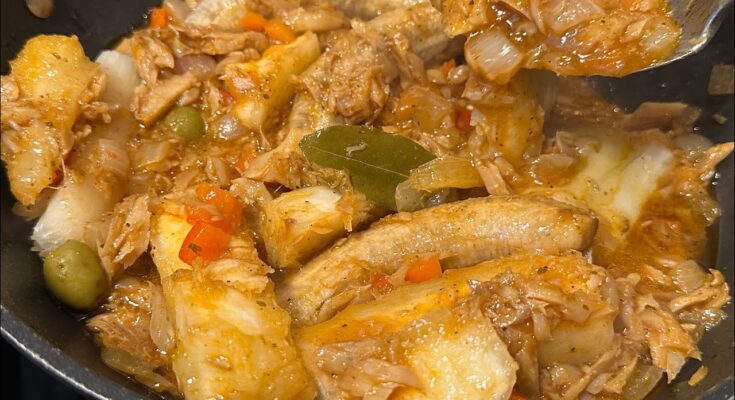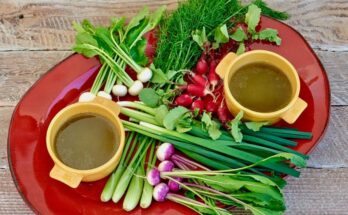Bacalao Recipe: Bacalao is more than just a dish—it’s a flavorful journey that spans continents and cultures. Whether you’re preparing it for a special occasion or as part of your weekly dinner rotation, bacalao never fails to impress.
In this comprehensive guide, we’re diving deep into the world of bacalao, covering everything from ingredients to plating it like a pro. Get ready to explore the rich flavors, textures, and aromas of this beloved salted cod dish.
What is Bacalao?
Bacalao is the Spanish term for salted codfish, and it has been a cornerstone of traditional cooking in many parts of the world, especially in Spain, Portugal, the Caribbean, and parts of Latin America. The preservation method—salting and drying—was used to extend the shelf life of fish before refrigeration existed, making bacalao an essential pantry staple.
When rehydrated and desalinated, the cod becomes tender and deeply flavorful, capable of absorbing rich spices, herbs, and sauces. It’s commonly stewed with tomatoes, onions, peppers, and olives, although there are dozens of regional variations. Bacalao is especially popular during Lent and other religious holidays, where it serves as a tasty alternative to meat.
History and Cultural Significance of Bacalao
Bacalao’s story goes back centuries. Originating from the North Atlantic cod fisheries, it became a global commodity in the 16th century. Portuguese and Spanish explorers introduced it to the Caribbean and Latin America, and its role in religious fasting traditions further cemented its popularity.
The simplicity of the ingredients belies the dish’s deep cultural significance. In countries like Puerto Rico, the Dominican Republic, and the Philippines, bacalao dishes have evolved into comfort food staples. In Europe, bacalao is often part of elaborate holiday meals. This humble fish has truly earned its global fame.
Types of Bacalao Dishes Around the World
Bacalao a la Vizcaína (Spain)
This Basque-style bacalao is slow-cooked in a rich red pepper and tomato sauce, often with olives and capers. It’s tangy, vibrant, and typically served with crusty bread.
Bacalao Guisado (Caribbean)
In the Caribbean, especially in Puerto Rico and the Dominican Republic, bacalao guisado is a stew made with salted cod, potatoes, onions, bell peppers, and olives. It’s hearty and often eaten with rice or fried plantains.
Baccalà alla Vicentina (Italy)
An Italian classic from the Veneto region, this version features cod slow-cooked in milk, onions, and anchovies until creamy and tender. It’s often served with polenta.
Why You Should Try Making Bacalao at Home
Why go through the trouble of desalting fish for 24 hours? Because the payoff is real. Making bacalao at home gives you total control over the flavor, saltiness, and texture. It’s surprisingly budget-friendly too—salt cod is inexpensive and shelf-stable.
Plus, homemade bacalao always tastes better than any prepackaged version. You get to enjoy the satisfaction of preparing a traditional dish that’s steeped in history while tailoring it to your taste. Want it spicier? Go for it. Prefer more tomato? Add an extra can. It’s flexible, forgiving, and delicious.
How to Choose the Best Salted Cod (Bacalao)
Not all salted cod is created equal. When buying bacalao, look for thick, firm fillets with a clean white color. Avoid any with a strong, off-putting smell or yellowish tint. Most supermarkets sell it in vacuum-sealed packages, but if you’re near a Latin or Mediterranean grocery, you might find whole dried slabs.
Also, check for bones. Some brands sell boneless pieces, while others are whole cuts that require extra prep. If you’re new to cooking bacalao, boneless is a safer bet. Quality makes all the difference here, so spend a little extra if needed.
Essential Tools and Utensils for Cooking Bacalao
Here’s what you’ll need:
- Large bowl (for soaking the cod)
- Sharp knife and cutting board
- Heavy-bottomed skillet or Dutch oven
- Wooden spoon
- Ladle
- Paper towels
- Strainer or colander
- Medium saucepan (for boiling optional ingredients like potatoes)
While you don’t need fancy gear, a good non-stick or enameled pot helps prevent the tomato sauce from sticking or burning. Trust me, it’s worth it.
Ingredients You’ll Need
Let’s get down to the core ingredients.
Main Ingredients
- 1 lb salted cod (bacalao)
- 1/4 cup olive oil
- 1 large onion, sliced
- 1 bell pepper, sliced (any color)
- 3 garlic cloves, minced
- 1 (14 oz) can diced tomatoes
- 1 tbsp tomato paste
- 1/2 cup green olives, pitted
- 1 tbsp capers (optional)
- 1/2 tsp ground black pepper
- 1/2 tsp paprika
- Fresh parsley for garnish
Optional Additions
- 2 boiled potatoes, cubed
- 1 hard-boiled egg, sliced
- A pinch of crushed red pepper
- 1/4 cup dry white wine
- Fresh thyme or oregano
Substitutes if You Can’t Find Salt Cod
If salted cod is unavailable, you can substitute with fresh cod and add more salt to the dish. It won’t have the same depth of flavor, but it’s still delicious. Alternatively, try using smoked whitefish or haddock for a different twist.
Step-by-Step Guide to Making Traditional Bacalao
Let’s break it down:
Step 1: Desalting the Cod
Rinse the salted cod under cold running water, then soak it in a large bowl of fresh water for 24–48 hours, changing the water every 6–8 hours. This removes excess salt and rehydrates the fish, restoring its tender texture and mild flavor.
Step 2: Prepping the Vegetables
Chop onions, garlic, bell peppers, and tomatoes into small pieces. These will create the aromatic foundation of your Bacalao. You can also add sliced olives or capers for a Mediterranean touch.
Step 3: Cooking the Base Sauce
Heat olive oil in a large pot. Sauté onions and garlic until translucent, then stir in bell peppers and tomatoes. Add tomato paste, paprika, and a splash of white wine. Let it simmer until thick and fragrant.
Step 4: Simmering the Bacalao
Add the soaked cod pieces to the sauce, cover, and simmer gently over low heat for 20–25 minutes. The fish will absorb the sauce while breaking into tender flakes—don’t stir too hard to avoid shredding it completely.
Step 5: Final Touches and Adjusting Seasoning
Taste and adjust with salt, pepper, and a pinch of chili flakes if you like a little heat. Garnish with fresh parsley and drizzle with olive oil before serving. Serve warm with boiled potatoes, rice, or bread for a hearty, comforting meal.
Pro Tips for Cooking Bacalao Perfectly
- Soak patiently: Don’t rush the desalting process. It’s worth the wait.
- Use high-quality olive oil: This dish relies heavily on it for richness.
- Don’t over-stir the cod: It can break into tiny pieces if handled too much.
- Layer your flavors: Start with a base and build up gradually. The difference is noticeable.
- Let it rest before serving: 10 minutes makes a huge difference in flavor.
If you’re making bacalao for guests, prepare it a few hours ahead. It tastes even better as the flavors develop.
How to Serve Bacalao
Bacalao is super versatile when it comes to serving. Traditionally, it’s spooned over a bed of white rice or served alongside boiled yuca or potatoes. In the Caribbean, it’s often paired with tostones (fried plantains), avocado slices, or even crusty bread for dipping into the sauce.
Here are a few serving ideas:
- With rice – Simple white rice lets the bold flavors shine.
- With fried plantains – Sweet and salty? Yes, please.
- With polenta or grits – A great Italian-American twist.
- In tacos or arepas – For something more modern and portable.
- With a fresh salad – Lightens up the plate, especially in warm weather.
Serve with a crisp white wine or cold beer, and you’ve got a meal that’s both satisfying and sophisticated.
Best Side Dishes to Pair with Bacalao
Choosing the right side dish for bacalao can elevate your meal from good to unforgettable. Since bacalao is already packed with intense, savory flavors, you want sides that complement rather than compete with it. Here’s a list of top side options that pair beautifully with this hearty dish:
1. Steamed White Rice
This is the go-to classic. Plain white rice acts like a sponge, soaking up all that rich tomato sauce and briny goodness from the cod. It’s simple, affordable, and lets the bacalao shine.
2. Boiled Yuca or Cassava
If you’re going Caribbean-style, you can’t go wrong with yuca. It’s dense, slightly nutty, and balances out the salty flavors of the cod. Drizzle with a bit of olive oil or garlic mojo sauce for extra flavor.
3. Fried Green Plantains (Tostones)
These crispy, salty bites add texture and depth to your plate. Their crunchy exterior contrasts beautifully with the soft, flaky cod.
4. Crusty Bread or Baguette
In many Spanish-speaking countries, bacalao is eaten with good crusty bread. It’s ideal for scooping up that saucy base and perfect if you’re not in the mood for rice.
5. Light Salad with Citrus Dressing
If you’re looking to keep things fresh, a simple salad with arugula, orange segments, and a citrus vinaigrette can cut through the richness of the dish. It adds brightness and a refreshing contrast.
6. Mashed Potatoes or Sweet Potatoes
Creamy mashed potatoes offer a smooth texture that works incredibly well with bacalao. Sweet potatoes add an extra layer of sweetness that balances the salty cod.
When choosing your sides, think about balance. Bacalao is bold and rich—you want accompaniments that either complement its flavor or provide a palate-cleansing contrast.
Storing and Reheating Bacalao
So, you’ve made a big pot of bacalao and have some leftovers. Great news: bacalao stores exceptionally well and often tastes better the next day as the flavors continue to meld. Here’s how to store and reheat it like a pro:
Storing:
- Refrigerator: Allow the dish to cool completely, then transfer it to an airtight container. It will stay fresh in the fridge for up to 4 days.
- Freezer: Yes, bacalao freezes beautifully. Use a freezer-safe container or zip-lock bag. It can last up to 3 months. Just label it with the date.
Reheating:
- Stovetop: This is the best method. Place your leftovers in a pan over medium heat with a splash of water or broth to prevent it from drying out. Stir occasionally until warmed through.
- Microwave: Quick but risky. Use a microwave-safe dish, cover loosely, and heat in 1-minute intervals, stirring in between. Be careful not to overcook, or the fish may become rubbery.
Avoid reheating multiple times. Instead, reheat only what you plan to eat in one sitting. That way, the texture and flavor remain as close to fresh as possible.
Variations of Bacalao Recipe You Can Try
One of the best things about bacalao is how versatile it is. Depending on where you are in the world—or what’s in your pantry—you can tweak the base recipe in a variety of ways.
1. Bacalao with Coconut Milk (Caribbean Style)
Add 1 cup of coconut milk after sautéing the vegetables. It adds a creamy, slightly sweet richness and balances the saltiness of the cod. Popular in Jamaica and some parts of the Dominican Republic.
2. Bacalao with Chickpeas (Spanish-Inspired)
Chickpeas add heartiness and are a great source of protein. Toss in a can of drained chickpeas with the tomatoes for a filling and satisfying twist.
3. Spicy Bacalao
If you like heat, stir in some chopped jalapeños, habaneros, or a teaspoon of cayenne pepper. Spicy bacalao pairs perfectly with a cold drink on a hot day.
4. Bacalao Empanadas
Use the bacalao mixture as a filling for savory empanadas or turnovers. Wrap in pastry dough and bake or fry for a delicious snack or appetizer.
5. Bacalao with Eggs (Breakfast-Style)
In some Latin cultures, shredded bacalao is mixed with scrambled eggs, onions, and tomatoes for a protein-packed breakfast. Serve with toast or tortillas.
With just a few ingredient swaps or additions, you can make bacalao your own. Don’t be afraid to experiment!
Common Mistakes to Avoid When Cooking Bacalao
Even though bacalao is relatively straightforward, there are a few common pitfalls that can mess up your dish. Here’s what to avoid:
1. Not Soaking the Cod Long Enough
This is the #1 mistake. Salt cod is extremely salty and needs at least 24 to 48 hours of soaking with multiple water changes. Skipping this step results in a dish that’s overwhelmingly salty.
2. Overcooking the Cod
Salted cod becomes tough and chewy when overcooked. Simmer it gently and only until it flakes easily. Be especially careful during the reheating stage.
3. Adding Too Much Salt to the Sauce
The cod, olives, and capers all bring saltiness to the dish. Taste before you season. You might not need any additional salt at all.
4. Not Using Enough Aromatics
The sauce is the soul of the dish. Don’t skimp on onions, garlic, and peppers—they build the base flavor. The more love you give the sauce, the better the bacalao.
5. Ignoring Texture
Bacalao should be saucy but not soupy. If your sauce is too watery, let it reduce further before adding the fish. On the other hand, if it’s too dry, add some broth or tomato juice.
Avoid these mistakes and you’ll have a dish worthy of praise every single time.
Nutritional Value of Bacalao
Bacalao isn’t just tasty—it’s pretty healthy too, especially when made with fresh vegetables and good-quality olive oil. Here’s a rough breakdown per serving (based on a traditional recipe):
| Nutrient | Amount (approximate) |
|---|---|
| Calories | 350–400 kcal |
| Protein | 35g |
| Fat | 15g (mostly healthy fats from olive oil) |
| Carbohydrates | 15–20g |
| Fiber | 3–5g |
| Sodium | Varies (based on soaking effectiveness) |
| Omega-3 Fatty Acids | High |
| Vitamin C | Good (from peppers and tomatoes) |
| Iron | Moderate |
Health Benefits:
- High Protein: Great for muscle repair and staying full.
- Low Carb: Suitable for keto or low-carb diets.
- Rich in Omega-3s: Good for heart and brain health.
- Low in Saturated Fat: When cooked with olive oil instead of butter or cream.
Of course, the sodium content depends on how thoroughly the cod is soaked and rinsed, so take care during prep.
FAQs about Bacalao Recipe
1. Can I use fresh cod instead of salted cod?
Yes, but it won’t have the same depth of flavor. If you do, add extra salt and consider seasoning the fish a few hours before cooking.
2. How long should I soak salted cod?
At least 24 hours, changing the water every 6–8 hours. For less salty versions, go up to 48 hours.
3. Is Bacalao spicy?
Traditionally, it’s not spicy—but you can easily add heat with chili flakes or hot peppers.
4. Can I freeze Bacalao after cooking?
Absolutely. Cool it completely, store in an airtight container, and freeze for up to 3 months. Thaw in the fridge overnight before reheating.
5. What wine pairs well with Bacalao?
A crisp Albariño, Sauvignon Blanc, or even a light Rosé complements the salty, savory profile of bacalao beautifully.
Conclusion
Making bacalao at home might feel like a bit of a project, but it’s totally worth it. From the salt-soaking prep to the simmering stew that fills your kitchen with irresistible aromas, every step is part of a culinary tradition passed down through generations.
This dish is flexible, nutritious, and full of bold, satisfying flavors. Whether you’re recreating a taste of home or trying it for the first time, bacalao is more than just a meal—it’s an experience.
Now that you’ve got the tools, tips, and step-by-step breakdown, there’s no excuse not to try it. Go ahead, give bacalao a shot. You might just find your new favorite comfort food.



